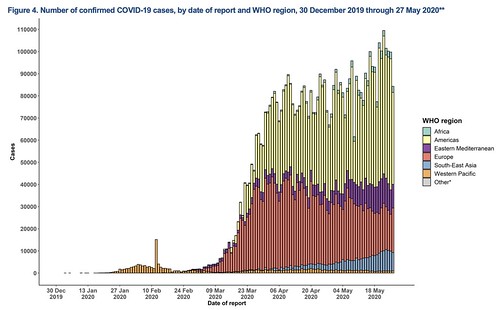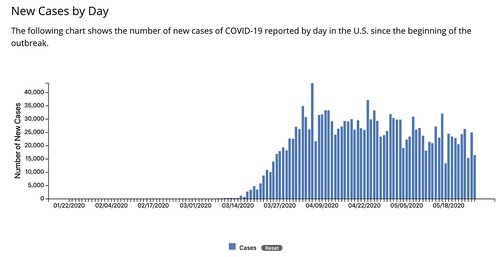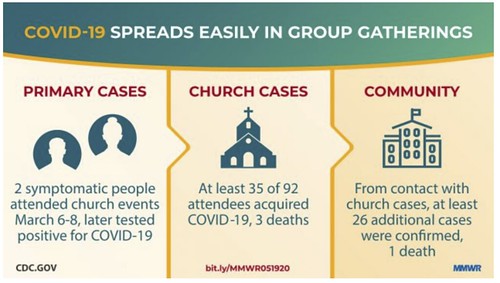As always, I’d like to take this time to remind everyone that I’m not a doctor. I’m more of a science and mathematics guy. These updates are meant as a way to turn the math and science of the COVID-19 outbreak into digestible English.
New Numbers
| World Health Organization | |
| Worldwide Cases | 5,488,825 |
| Worldwide Deaths | 349,095 |
| CDC | |
| Total U.S. Cases | 1,678,843 |
| Total U.S. Deaths | 99,031 |
| Johns Hopkins | |
| Total Worldwide Cases | 5,731,837 |
| Total Worldwide Deaths | 356,606 |
| Total U.S. Cases | 1,703,989 |
| Total U.S. Deaths | 100,651 |
Graphs
From the WHO:
From the CDC:
From Brian McNoldy:
For Mississippi:
Regional Cases
| Total Cases | Tested | Deaths | %-positive | Mortality Rate | |
| MS | 14372 | 163530 | 693 | 8.79% | 4.82% |
| LA | 38497 | 347647 | 2617 | 11.07% | 6.80% |
| AL | 16094 | 199651 | 590 | 8.06% | 3.67% |
| TN | 21306 | 409630 | 353 | 5.20% | 1.66% |
| AR | 6277 | N/A | 120 | N/A | 1.91% |
| Total | 96546 | 1120458 | 4373 | 8.62% | 4.53% |
Regional Hospitalizations
| Hospitalized | Ventilators | Percent Hospitalized | |
| MS | 449 | 148 | 3.12% |
| LA | 798 | 100 | 2.07% |
| AL | 553 | N/A | 3.44% |
| TN | 1647 | N/A | 7.73% |
| AR | 1750 | N/A | N/A |
| Total | 5197 | 248 | 4.09% |
Making Estimations
I talked about research from the Cruise Ships that may be relevant to estimating the number of cases without testing everyone (since that isn’t a feasible option). Plus, this type of estimate would make a good “first guess” at the number of asymptomatic people (the people who don’t feel sick, but are still infected), too.
This type of estimating isn’t perfect. In fact, it is far from it. And it is just an estimate. But based on the past research, it is at least a start.
| Estimated Symptomatic | Estimated Asymptomatic | Estimated total | |
| MS | 21920 | 4812 | 26732 |
| LA | 58716 | 12889 | 71604 |
| AL | 24547 | 5388 | 29935 |
| TN | 32496 | 7133 | 39629 |
| AR | 9574 | 2102 | 11675 |
| Total | 147252 | 32324 | 179576 |
In Mississippi
Using the CDC estimate of illness-length as a guide (two weeks), the number of ‘currently sick’ people can be estimated – for both symptomatic and asymptomatic.
| Symptomatic | Estimated Asymptomatic | Total Infected |
| 4282 | 940 | 5222 |
As I pointed out the other day, while that number may appear very small compared to the total number of people living in Mississippi (about 3.5 million), the ratio of people per square mile – given the high rate of transmission – becomes an important number to calculate, too. And in this case it is reasonably small.
With 5222 people estimated to be currently sick, that puts one sick person for every 9.3 miles. And since the average American travels more than 20 miles per day, it means people will have an increased chance of interacting with a COVID-infected person.
From the Mayo Clinic
New research from the Mayo Clinic points to managing “levels of calcium in the blood and the protein albumin early on in COVID-19 may prevent patients from progressing to severe illness” and even death.
The findings were recently published in the journal Gastroenterology found. Researchers based found a similarity between “clinical features and autopsy results of patients who died of COVID-19 and patients whose organ failure resulted from the release of unsaturated fatty acid caused by other illnesses,” says lead researcher Vijay Singh, MBBS, a gastroenterologist at Mayo Clinic in Arizona.
Supplementing serum calcium and albumin to maintain normal levels, starting early and continuing throughout a COVID-19 infection may help bind and neutralize unsaturated fatty acids and prevent organ failure while giving the patient time to fight and clear the infection, Dr. Singh says.
“This may help to prevent severe cases of COVID-19, and the need for patient treatment in intensive care units,” he says. “Supplementation to achieve and maintain normal serum calcium and albumin levels is safe and can easily be tested in clinical trials.”
On the Mayo Clinic Q&A podcast, Eric Hargan, HHS deputy secretary, discusses the ways the department is supporting Americans during the COVID-19 pandemic.
From the CDC
The CDC is still encouraging everyone to wear a mask when in public and continue to practice social distancing.
In a new report written in the Morbidity and Mortality Weekly Report (MMWR), researchers look at a single Church in Arkansas to see how the spread of Coronavirus acted in large gatherings. The results were sobering.
“Among 92 attendees at a rural Arkansas church during March 6–11, 35 (38%) developed laboratory-confirmed COVID-19, and three persons died. Highest attack rates were in persons aged 19–64 years (59%) and ≥65 years (50%). An additional 26 cases linked to the church occurred in the community, including one death.”
According to the CDC there were only two people that came to church that Sunday with COVID-19. The Pastor and his wife.
From the report:
The couple (the index cases) attended church-related events during March 6–8, and developed nonspecific respiratory symptoms and fever on March 10 (wife) and 11 (husband). Before his symptoms had developed, the husband attended a Bible study group on March 11. Including the index cases, 35 confirmed COVID-19 cases occurred among 92 (38%) persons who attended events held at [the church] during March 6–11; three patients died. The age-specific attack rates among persons aged ≤18 years, 19–64 years, and ≥65 years were 6.3%, 59.4%, and 50.0%, respectively.
During the investigation, two church A participants who attended the March 6–8 children’s event were found to have had onset of symptoms on March 6 and 7; these represent the primary cases and likely were the source of infection of other church A attendees (Figure). The two out-of-state guests developed respiratory symptoms during March 9–10 and later received diagnoses of laboratory-confirmed COVID-19, suggesting that exposure to the primary cases resulted in their infections. The two primary cases were not linked except through the church; the persons lived locally and reported no travel and had no known contact with a traveler or anyone with confirmed COVID-19. Patient interviews revealed no additional common exposures among church attendees.
In total, those two people were – unknowingly – responsible for 118 cases and four deaths.
Research backs up mask recommendation
Research in the New England Journal of Medicine shows that droplets capable of carrying the virus are released when simply talking. The ‘correspondence’ titled, “Visualizing Speech-Generated Oral Fluid Droplets with Laser Light Scattering” used a laser light-scattering experiment in which speech-generated droplets and their trajectories were visualized.
From the authors:
The output from a 532-nm green laser operating at 2.5-W optical power was transformed into a light sheet that was approximately 1 mm thick and 150 mm tall. We directed this light sheet through slits on the sides of a cardboard box measuring 53×46×62 cm. The interior of the box was painted black. The enclosure was positioned under a high-efficiency particulate air (HEPA) filter to eliminate dust.
When a person spoke through the open end of the box, droplets generated during speech traversed approximately 50 to 75 mm before they encountered the light sheet. An iPhone 11 Pro video camera aimed at the light sheet through a hole (7 cm in diameter) on the opposite side of the box recorded sound and video of the light-scattering events at a rate of 60 frames per second. The size of the droplets was estimated from ultrahigh-resolution recordings. Video clips of the events while the person was speaking, with and without a face mask, are available with the full text of this letter at NEJM.org.
The researchers found that when people said a casual reminder to, “stay healthy” numerous droplets ranging from 20 to 500 μm were generated. The volume of speaking did have an influence on the number of droplets created.
According to the CDC:
Cloth face coverings should…
— fit snugly but comfortably against the side of the face
— be secured with ties or ear loops
— include multiple layers of fabric
— allow for breathing without restriction
— be able to be laundered and machine dried without damage or change to shape
CDC recommends wearing cloth face coverings in public settings where other social distancing measures are difficult to maintain (e.g., grocery stores and pharmacies), especially in areas of significant community-based transmission.
CDC also advises the use of simple cloth face coverings to slow the spread of the virus and help people who may have the virus and do not know it from transmitting it to others. Cloth face coverings fashioned from household items or made at home from common materials at low cost can be used as an additional, voluntary public health measure.
Cloth face coverings should not be placed on young children under age 2, anyone who has trouble breathing, or is unconscious, incapacitated or otherwise unable to remove the mask without assistance.
The cloth face coverings recommended are not surgical masks or N-95 respirators. Those are critical supplies that must continue to be reserved for healthcare workers and other medical first responders, as recommended by current CDC guidance.
The CDC says that you should be careful not to touch your eyes, nose, or mouth when removing the mask. And wash your hands immediately after removing.
The CDC has a few quick tips on making your own mask. One way, with no sewing needed, is by cutting an old Tshirt.
There is more information and a tutorial on how to make your own mask here: https://www.cdc.gov/coronavirus/2019-ncov/prevent-getting-sick/diy-cloth-face-coverings.html
Final Notes
Two quick notes. The first is that I had a chance to chat with a local nurse this past weekend. She wanted to urge people to not put off seeking medical attention if you need it. She told me the story of a person who put off seeking medical help for something non-COVID-related because he didn’t want to go to into a hospital or doc office due to the fear of getting the virus.
That man is about to die from something that was completely avoidable had he went in when the issue began.
The nurse was adamant: Seek medical attention immediately for a heart attack, stroke, or other life-altering medical condition. The hospitals and doc offices are equipped to take care of you while keeping you isolated from the threat of COVID-19.
The other note is to please be safe. I want everyone to get through this. And, from the conversations I’ve had with people I want to really urge folks to consider that wearing a mask, social distancing, and taking steps to mitigate the spread of this virus are not signs of weakness. They are signs of strength.
Most of you that read this are helpful people. You all do it in different ways, too. Some of you volunteer at an animal shelter. Others of you watch neighbors’ kids on the weekend, some of you carry a gun on your hip in public ‘just incase’ someone tries something. And a lot of people appreciate the efforts all of you go through – in your own way – to be helpful.
You’re good people. I know it.
I also know that wearing a mask is no fun. Avoiding shaking hands and high-fiving is no fun. Missing graduations and birthday parties is the worst.
But it is important. To keep you healthy, for sure. But it is also to keep others healthy, too.
The case of the two people who didn’t know they were sick spreading the virus to more than 100 people, killing four is – perhaps – an isolated incident. But what if that was you? Would you want to know that you were responsible for that? I would not. And I think most of you, being as helpful as you are, would not want to be responsible for that either.
A great way to mitigate that threat is to wear a mask, practice social distancing and avoid close contact with others. Yes, it stinks. It is no fun at all. But it can help protect others. And I think that is what a lot of you do on a regular basis already.
This is just a new way to do it.







